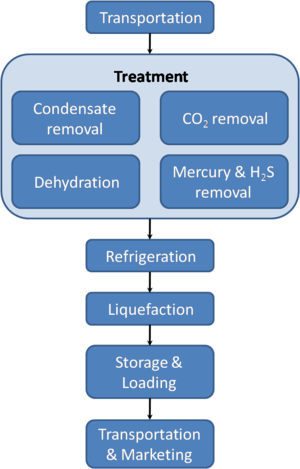When your company ships its products to your customers, wouldn’t you like to be able to shrink the volume 600 times to save on shipping costs? If you’re in the business of liquefied natural gas (LNG), that’s exactly what you do. And, with the increasing production of shale gas in the United States and other areas of the world, LNG opens up the ability to transport this gas over great distances in its liquid state.
The liquefied natural gas Wikipedia entry describes the process:The liquefaction process involves removal of certain components, such as dust, acid gases, helium, water, and heavy hydrocarbons, which could cause difficulty downstream. The natural gas is then condensed into a liquid at close to atmospheric pressure (maximum transport pressure set at around 25 kPa/3.6 psi) by cooling it to approximately −162 °C (−260 °F).
In an NGV [Natural Gas Vehicles] Journal article, LNG as the fuel of the future, Emerson’s Arjan van Ginkel shares some of the reasons why LNG, its challenges, and ways technology helps with these challenges. From an environmental standpoint [hyperlink added]:
LNG has a very high concentration of methane, a little nitrogen and propane, with hardly any toxic gases. When LNG burns, it releases emission level that is close to zero. The methane percentage in this fuel can be as high as 96 to 98 percent. LNG is seen as an important factor to meet the 2020 environmental target of the greenhouse gas emission reduction scheme.
From a process automation viewpoint:
Cryogenic liquid is difficult to handle during transport. There is also a challenge to avoid gasification during the transportation of this fuel. The state of the fuel-in very low temperature-influences the performance of any process component.
A key measurement for LNG is the Gas Caloric Value (GCV) or the energy content. Arjan notes:
Measuring by mass is much more accurate and allows a much better calculation of the actual value of the fuel. By volume, the density also needs to be calculated. This requires two measuring devices and a calculation. Measuring this way, you will lose the accuracy and, thus, the actual rate of LNG.
A Coriolis flow and density meter is a good fit for this application because:
…it measures mass and density directly from the flow without disturbing the flow line. It also allows very accurate measurement of the mass flow rate. The best meter can reach an accuracy of as precise as 99.8 percent, and error of ±0.2% on LNG. Under normal conditions it can get as good as 0.05 percent in possible error rate.
Due to their measurement repeatability, these Micro Motion Coriolis meters have Measuring Instruments Directive (MID) 2004/22/EC approval, which:
…is a directive by the European Union, which intends to create a common market for measuring instruments across the 27 countries of the EU. Its most prominent tenet is that all kinds of meters which receive a MID approval may be used in all countries across the EU.
The use of this measurement technology extends across the transportation supply chain:
…from the ‘production’ of natural gas, the processing of the liquefaction and transportation to the decentralized gasification, truck / barge distribution and dispensing/bunkering.
If you’re in the area, Arjan and the team will be presenting at the LNG 4 Trucks And Ships Workshop in Amsterdam (September 19-21, 2012). Also, check out the whitepaper, Cryogenic Service with Micro Motion Flowmeters for more on how Coriolis technology works in cryogenic applications.





